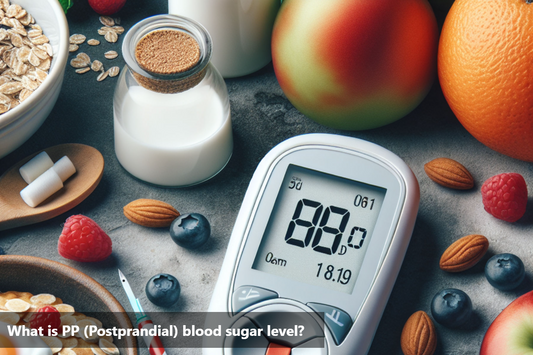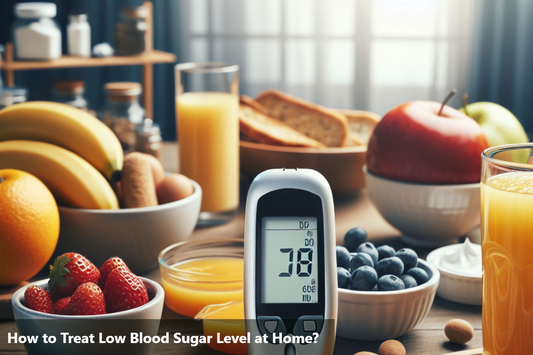PPBS, or Postprandial Blood Sugar, is the blood sugar level measured after meals. Understanding the normal range of PPBS is crucial for assessing blood sugar control and overall health. It plays a significant role in managing diabetes, detecting health issues early, and maintaining optimal health. Knowing the normal range of PPBS helps individuals make informed decisions about diet and lifestyle, empowering them to lead a healthier life.
Factors Affecting PPBS Levels
-
Diet: Consuming a diet high in sugar and carbohydrates can lead to spikes in PPBS readings, while a balanced diet rich in fiber, proteins, and healthy fats can help maintain stable PPBS levels.
-
Exercise: Regular physical activity helps the body utilize glucose effectively, contributing to better PPBS results by improving insulin sensitivity and managing PPBS levels.
-
Age and Gender: As individuals age, changes in the body's ability to regulate blood sugar may lead to fluctuations in PPBS readings. Gender differences can also impact PPBS levels, with women often experiencing variations due to hormonal influences.
Who Should Get a Post-Prandial Blood Sugar (PPBS) Test?
Regular monitoring of blood sugar levels is crucial for individuals with diabetes or those at risk of developing the condition. A Post-Prandial Blood Sugar (PPBS) test is recommended for individuals with diabetes to measure blood sugar levels after a meal. This test helps healthcare providers assess how the body processes glucose and how effectively insulin is being utilized. Individuals with diabetes, especially those struggling to control their blood sugar levels, should consider getting a PPBS test to manage their condition effectively.
Normal Range for PPBS
-
The normal range for Postprandial Blood Sugar (PPBS) is a critical indicator of overall health and well-being.
-
It typically refers to the blood sugar levels after a meal and provides valuable insights into metabolic function.
-
For the general population, the normal range for PPBS is usually between 140-200 mg/dL.
-
However, it's important to note that this range can vary based on individual factors such as age, gender, and underlying health conditions.
-
When considering PPBSnormal range for females specifically, it's essential to be aware that hormonal fluctuations during the menstrual cycle can influence blood sugar levels.
-
Women may experience slightly different normal ranges compared to men due to these factors.
-
Additionally, conditions like polycystic ovary syndrome (PCOS) or pregnancy can further impact PPBS levels in females.
-
Understanding the normal range for PPBS is crucial for monitoring and managing blood sugar levels effectively.
-
By staying within the recommended range, individuals can reduce the risk of developing complications related to diabetes and maintain optimal health.
-
Monitoring PPBS regularly, especially after meals, can provide valuable information about how the body responds to food intake and help in making informed decisions about dietary choices and overall well-being.
Interpreting PPBS Results
-
When interpreting PPBS results, understanding alignment with normal range is crucial. PPBS levels provide insights into health, especially related to glucose metabolism. Ideally, results should fall within normal range, indicating stable blood sugar post meals. Deviation may signal glucose regulation issues, requiring attention.
-
Normal range implies effective glucose processing for good health.
-
Elevated levels may suggest insulin resistance, diabetes, or metabolic disorders.
-
Consult a healthcare provider if levels are outside normal range for evaluation and recommendations. Accurate interpretation helps manage health and prevent complications from abnormal blood sugar levels. Stay informed, vigilant, and prioritize well-being.
Bottom line:
Understanding the normal range for Postprandial Blood Sugar (PPBS) is crucial for maintaining health. By knowing the target PPBS levels, individuals can monitor their blood sugar effectively and prevent complications. This knowledge helps in making informed decisions about diet, activity, and lifestyle, reducing the risk of serious health conditions such as diabetes and cardiovascular diseases. Females should be especially aware of gender-specific ranges due to hormonal and metabolic differences. Overall, knowing the PPBS range empowers individuals to manage health proactively, leading to stable blood sugar levels and improved quality of life. Regular monitoring and staying within the recommended range are key for promoting health and preventing complications.
FAQs:
-
What is the normal range for PPBS?
Answer: The normal range for a Postprandial Blood Sugar (PPBS) test is typically between 140 to 199 mg/dL.
-
How is PPBS measured?
Answer: PPBS is measured using a blood sample taken 2 hours after a meal.
-
Why is PPBS important for diabetes management?
Answer: PPBS helps evaluate how the body processes sugar after a meal, aiding in diabetes management and monitoring blood glucose control.
-
What factors can affect PPBS levels?
Answer: Factors like diet, physical activity, medication, stress, and sleep can impact PPBS levels.
-
When should one monitor their PPBS levels?
Answer: It is recommended to monitor PPBS levels regularly, especially if diagnosed with diabetes, to track post-meal blood sugar spikes and maintain control.
This Blog post is an initiative by DiabeSmart, to provide accurate and Nutritionist / Doctor approved information related to Diabetes. DiabeSmart is India's first Food brand designed specifically for Diabetics, that has been clinically tested on Diabetics and Pre-Diabetics to deliver 55% - 70% lower Sugar spikes. DiabeSmart is part of Lo! Foods - India's leading brand for Everyday Functional Health foods.















